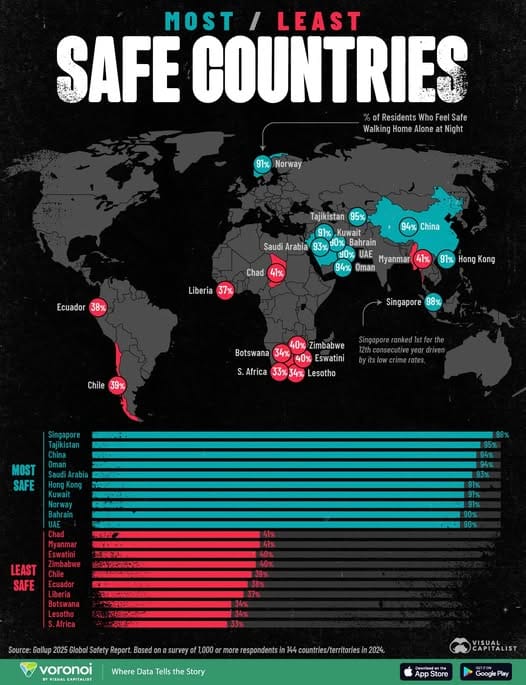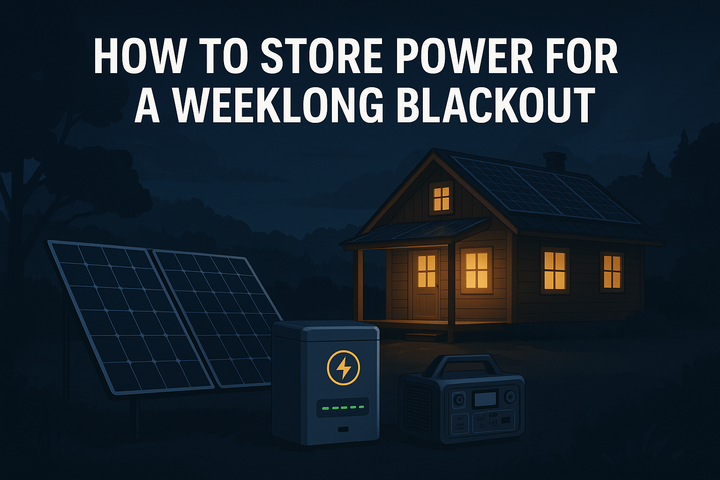The World’s Safest (and Least Safe) Countries in 2025

Based on Gallup’s 2025 Global Safety Report
How safe does the world feel in 2025? Gallup’s latest Global Safety Report surveyed more than 1,000 residents in 144 countries and asked a simple question: Do you feel safe walking alone at night?
The answers paint a clear picture of global trust, stability, and everyday security. Some countries enjoy extremely high confidence in public safety, while others continue to struggle with crime, conflict, or institutional weakness.
Below is a breakdown of the safest and least safe countries in 2025, based on the data shown in the global map.

Most Safe Countries in 2025
The top scoring countries share several characteristics: strong rule of law, low violent crime, robust policing, and a high degree of social trust.
Singapore (89 percent)
Singapore holds the number one spot for the ninth consecutive year. Residents consistently report feeling secure in public spaces thanks to low crime rates, strict laws, and well maintained urban infrastructure.
Tajikistan (95 percent)
Tajikistan’s rating continues to surprise global audiences. Respondents report strong community ties and relatively low rates of day to day crime.
China (94 percent)
China shows high public confidence in safety, driven by heavy surveillance, strict enforcement, and a tightly managed public environment.
Kuwait (91 percent)
Kuwait maintains a high score thanks to its stability, wealth, and effective security services.
Norway (91 percent)
Norway is the strongest performing Western nation. High social trust and low violent crime contribute to excellent feelings of safety.
Saudi Arabia (91 percent)
Residents report strong confidence in public safety, supported by low street crime and firm enforcement.
Hong Kong (91 percent)
Despite political tensions in recent years, Hong Kong remains one of the safest regions in terms of personal security and low crime levels.
United Arab Emirates (91 percent)
A reputation for strict security and a highly monitored environment keeps residents feeling safe.
Buy & Sell Bitcoin, Dollar Cost Average management and pay your bills with Bitcoin on the the best Bitcoin only Exchange.
Least Safe Countries in 2025
Countries with low safety scores often face conflict, instability, economic hardship, or high crime rates. These factors heavily influence how secure residents feel in their daily lives.
Chad (40 percent)
Chad ranks as the least safe country. Ongoing conflict and institutional weakness create a challenging security environment.
Zimbabwe (40 percent)
Economic strain and elevated crime contribute to low public confidence in safety.
Eswatini (34 percent)
High crime rates and weak policing capacity affect the country’s ranking.
South Africa (33 percent)
South Africa continues to struggle with high levels of violent crime and inequality, affecting both urban and rural communities.
Lesotho (31 percent)
Crime, limited enforcement, and economic challenges place Lesotho near the bottom of global perceptions of safety.
Liberia (37 percent)
Still recovering from conflict, Liberia faces ongoing issues related to crime and public security.
Ecuador (38 percent)
Ecuador has experienced increasing gang activity and organized crime, sharply lowering public confidence.
Chile (39 percent)
Recent increases in urban crime have weakened perceptions of safety.
What the Rankings Reveal
Safety is multidimensional.
Trust, community cohesion, governance, and economic stability matter just as much as crime statistics.
Stability produces confidence.
Small, organized nations or wealthy states tend to perform best because residents feel protected by strong institutions.
Instability drives fear.
Countries facing conflict or economic decline see sharp drops in personal safety perceptions.
Why These Insights Matter
Feeling safe affects everything:
Travel decisions, investment confidence, tourism, migration, and overall wellbeing.
This data also highlights where governance and social investments pay off, and where instability creates real and lasting concerns for citizens.



Comments ()